I. Introduction
The Dairy Situation Report presents the industry situation in terms of volume of production, inventory, and average farmgate prices of dairy animals, which includes cattle, goat, and carabao. It serves as a ready reference for the various clients and stakeholders of the Philippine Statistics Authority (PSA) in the agriculture sector.
The data for this report were sourced from the administrative records of the National Dairy Authority (NDA) and Philippine Carabao Center (PCC), and from the two surveys conducted by the PSA, namely, Backyard Livestock and Poultry Survey (BLPS) and the Commercial Livestock and Poultry Survey (CLPS).
The data on volume of production for dairy cattle and dairy goat were sourced from the administrative records of NDA, while data for dairy carabao was obtained from the PCC-assisted dairy cooperatives. These are supplemented by data generated from the BLPS and CLPS.
The BLPS aims to generate estimates on the supply and disposition of livestock and poultry commodities at the household level. In the third quarter of 2023, the number of sample households covered was 21,728 from the 1,156 sample barangays nationwide. On the other hand, the CLPS seeks to generate estimates on the supply and disposition of livestock and poultry commodities from the sample establishments. There were 71 dairy establishments covered in the third quarter of 2023.
Both surveys are conducted quarterly in all provinces, including National Capital Region (NCR). Moreover, the commodities covered in the surveys include: cattle, carabao, swine, goat, chicken, duck, and other animals raised/tended by households and establishments.
II. Data Collection
A. Backyard Livestock and Poultry Survey
1. Data collection procedure
The field data collection for the third quarter of 2023 was conducted from 02 to 09 October 2023. The data collection was undertaken by hired Statistical Researchers (SRs) through face-to-face interview with qualified respondents of the sample households. Prior to data collection, training of selected staff from Field Offices, including SRs, was conducted to ensure uniform understanding of concepts and proper implementation of survey procedures. Field and manual editing of the accomplished questionnaires was done to ensure completeness, consistency, and reasonableness of the information gathered.
2. Survey Questionnaire
The BLPS Questionnaire is a 19-page form composed of 16 blocks that aims to gather information on the basic characteristics and operations of the household.
The data items included in the survey are as follows:
a. Type of household operation/purpose
b. Inventory by age
c. Breeder that gave birth
d. Supply indicator (number of births, received/acquired)
e. Slaughtered in the household
f. Sold live for slaughter
g. Sold live for other purposes (breeding, fattening)
h. Average farmgate price
I. Milk production indicators (animals on the milk line, average milk production)
j. Deaths/Losses
k. Average liveweight per head
l. Disposition by areas of destination
m. Assessment of household’s production
B. Commercial Livestock and Poultry Survey
1. Data collection procedure
The schedule of field data collection for the third quarter of 2023 was during the last 10 days of September 2023. The data collection was undertaken by hired SRs through face-to-face interview with qualified respondents of the farms/establishments. Prior to data collection, training of Field Office personnel, including SRs, was conducted to ensure that the procedures and concepts of the survey are understood and properly implemented. Field and manual editing of the accomplished questionnaires was done to ensure completeness, consistency, and reasonableness of the information gathered.
2. Survey Questionnaire
The CLPS Survey Questionnaire aims to gather necessary information on supply and disposition of dairy commercial farms/establishments.
The data items included in the survey are as follows:
The data items included in the survey are as follows:
a. Type of establishment operation
b. Inventory by age
c. Supply indicator (number of births, received/acquired)
d. Slaughtered in the establishment
e. Sold live for slaughter
f. Sold live for other purposes (breeding, fattening, drafting)
g. Average farmgate price
h. Milk production indicators (animals on the milk line, average milk production)
i. Deaths/Losses
j. Average liveweight per head
k. Disposition by areas of destination
l. Assessment of establishment’s production
C. Compilation of Administrative-based Data on Milk Production and Farm Prices from PCC and NDA
1. Data collection procedure
The PCC and NDA monitor and regularly record the monthly data related to dairy. Every quarter, the PSA-Central Office (CO) through the Livestock and Poultry Statistics Division (LPSD) provides a form to PCC and NDA for the consolidation of report. The PCC and NDA accomplish the form and submit to PSA-LPSD through email every 20th day after the reference quarter.
2. Consolidation Form
The consolidation form aims to gather information on the performance of dairy in assisted/monitored dairy farms in covered areas of PCC and NDA.
The data items included in the form are as follows:
a. Total inventory of dairy animals
b. Number of breeder animals
c. Number of animals in the milkline
d. Volume of production
e. Average farmgate price
III. Sampling Design
A. Backyard Livestock and Poultry Survey
1. Sampling Frame
The BLPS sampling frame is based on the results of the 2017 Listing of Farm Households (LFH) and 2012 Census of Agriculture and Fisheries (CAF). For barangays not covered in the 2017 LFH, the list of households was taken from the 2012 CAF. The sampling frame is updated quarterly based on the status of the sampled households using structured Frame Maintenance Form (FMF) submitted by the Provincial Statistical Offices every quarter.
2. Sample Selection Procedure
The BLPS uses two-stage sampling design. The first stage is the selection of sample barangays or Primary Sampling Units (PSUs) using probability proportional to size where the measure of size is the total animal inventory.
The second stage is the selection of sample households or Secondary Sampling Units (SSUs) that are engaged in livestock and poultry raising in the sampled barangays using systematic sampling.
The number of sample households per selected barangay is 20 but this could be less if the selected barangay has less than 20 households. The sample households per quarter are independent.
The sample size was determined based on a five percent (5%) target coefficient unit of variation.
3. Domain
The domain of the survey is the province. In the case of NCR, the region is the domain.
4. Estimation Procedure
a. Survey Weight
a.1. Base Weight
PSU Weight
The PSU weight is computed as follows:
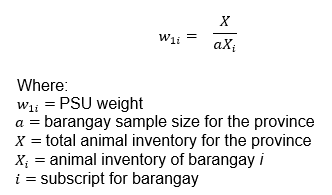
SSU Weight
The SSU weight is computed as follows:
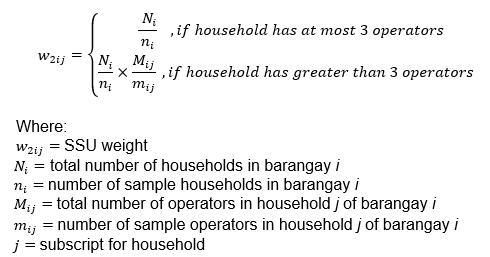
Base Weight
The base weight is the product of the PSU and SSU weights. That is,

a.2. Adjustment Factor
The adjustment factor to account for non-response is given as follows:
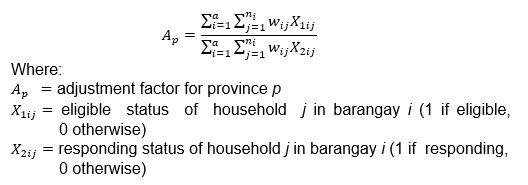
Eligible households are the following:
- Interview completed;
- Refused to be interviewed without replacement;
- Temporarily away/Not at home without replacement; and
- HH temporarily not accessible without replacement.
Ineligible households are the following:
- Resides outside the barangay;
- Unknown in the locality; and
- Deceased (No other livestock and poultry operator in the household).
a.3. Final Weight
The final weight formula is given as follows:
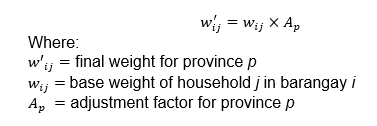
b. Estimation of Total
b.1. Estimation of Provincial Total
Estimation of provincial total is done per animal type and the formula is
given as follows:

b.2. Estimation of Regional and National Total
The regional estimates are obtained by aggregating the estimates for the provinces within the region, while the national estimates are derived by adding all the regional estimates obtained in each region.
B. Commercial Livestock and Poultry Survey
1. Sampling Frame
The CLPS frame is based on the results of the 2021 Updating of the List of Establishments (ULE). It is updated quarterly based on the results of visit of the sample farms/establishments using the FMF.
2. Sample Selection Procedure
The CLPS uses stratified probability proportional to size sampling design, where the establishment is the primary sampling unit. The animal type serves as a stratification variable and the size measure is the maximum farm/housing capacity of the establishment. Per animal type, the establishments are sorted by maximum farm/housing capacity and sample establishments are selected using systematic sampling. A panel sample establishment is maintained for a year and a new set of samples is selected during the first quarter of the following year.
Complete Enumeration (CE) is applied for provinces with less than 25 commercial farms/establishments, otherwise, sampling is used.
3. Domain
The domain of the survey is the province. In the case of NCR, the region is the domain.
4. Estimation Procedure
a. Survey Weight
a.1. Base Weight
The base weight per animal type is given as follows:
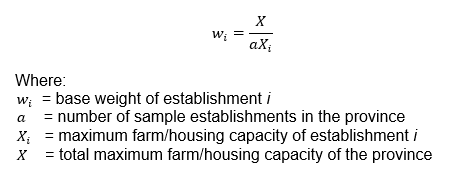
a.2. Adjustment Factor
The adjustment factor to account for non-response is given as follows:

Eligible establishments are the following:
- Operational
- Refusal
- Cannot be contacted/Not accessible
Ineligible establishments are the following:
- Temporarily Stopped Operation
- Permanently Closed/Stopped Operation
- Shifted Farm Operation
- Cannot Be Located
- Duplicate
- Out-of-scope - Recreation
- Out-of-scope - Change Sector
- Out-of-scope - Main Office/Ancillary Unit
a.3. Final Weight
The final weight formula is given as follows:
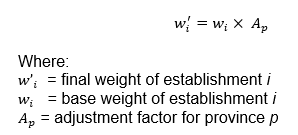
b. Estimation
b.1. Estimation for the Province
Estimation of provincial total is done per animal type and the formula is given as follows:

b.2. Estimation of Regional and National Total
The regional estimates are obtained by aggregating the estimates for the provinces within the region, while the national estimates are derived by adding all the regional estimates obtained in each region.
IV. Consolidation of Dairt Estimates
To estimate the dairy production, the data generated from BLPS and CLPS are then aggregated to the administrative data obtained from PCC and NDA. To avoid duplicates in the recording of data, the PSA only includes the milk produced that were not sold to PCC and NDA-assisted cooperatives.
V. Concepts and Definitions of Terms
Farmgate price refers to the price received by raisers for their produce at the location of farm. Thus, marketing costs, such as the transport and other marketing costs (if any) incurred in selling the produce, are not included in the farmgate prices.
Inventory refers to the actual number of dairy animals present in the farm as of a specific reference date.
Volume of production refers to the volume of milk produced by locally-raised dairy animals. This is expressed in metric tons.
VI. Dissemination of Results and Revision
The PSA disseminates the Dairy Situation Report quarterly and is uploaded in the PSA Website.
The livestock and poultry statistics follows the revision policy as stipulated in the PSA Board Resolution No. 1, Series of 2017-119 approving the revision of quarterly estimates on agricultural production, prices, and related statistics to be limited to the immediately preceding quarter and for the past three years with quarterly breakdown to be done only during May of the current year.
VII. Citation
Philippine Statistics Authority. (21 November 2023). Technical Notes on Q3 2023 Dairy Situation Report. https://psa.gov.ph/livestock-poultry-iprs/dairy/technical-notes
VIII. Contact Information
Precious S. Jacinto
(Supervising Statistical Specialist)
Officer-in-Charge
Livestock and Poultry Statistics Division
Economic Sector Statistics Service
Sectoral Statistics Office
Philippine Statistics Authority
Email Address: p.jacinto@psa.gov.ph
For data request, you may contact the:
Knowledge Management and Communications Division
Telephone: (632) 8462-6600 loc. 839
Email Address: info@psa.gov.ph

